My morning routine
This is a mini-workout I like to do in the morning. I consider it my body’s essential maintenance.
tl;dr
Don’t have time to read my rambling explanations? Just do this as many mornings as you can manage:
Arm swings: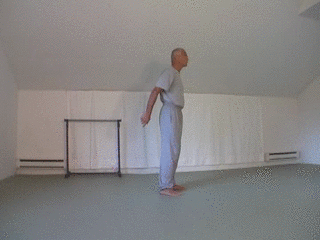 Leg swings forward:
Leg swings forward:![[:br]Leg swings backward:[:br][:img {:src "/public/img//kurz-gifs/tom kurz - leg raises to rear.sm.gif", :alt "[:br]Leg swings sideward:[:br][:img {:src \"/public/img//kurz-gifs/tom kurz - leg raises to side.sm.gif\", :alt \"[:br]Excerpted from Tom Kurz’ DVD [:a {:href \\\"https://www.stadion.com/flexibility-express/\\\"} (\\\"Flexibility Express\\\")]\", :title \"[:br]Excerpted from Tom Kurz’ DVD [:a {:href \\\"https://www.stadion.com/flexibility-express/\\\"} (\\\"Flexibility Express\\\")]\"}]", :title "[:br]Leg swings sideward:[:br][:img {:src \"/public/img//kurz-gifs/tom kurz - leg raises to side.sm.gif\", :alt \"[:br]Excerpted from Tom Kurz’ DVD [:a {:href \\\"https://www.stadion.com/flexibility-express/\\\"} (\\\"Flexibility Express\\\")]\", :title \"[:br]Excerpted from Tom Kurz’ DVD [:a {:href \\\"https://www.stadion.com/flexibility-express/\\\"} (\\\"Flexibility Express\\\")]\"}]"}] [:br]Leg swings backward:[:br][:img {:src "/public/img//kurz-gifs/tom kurz - leg raises to rear.sm.gif", :alt "[:br]Leg swings sideward:[:br][:img {:src \"/public/img//kurz-gifs/tom kurz - leg raises to side.sm.gif\", :alt \"[:br]Excerpted from Tom Kurz’ DVD [:a {:href \\\"https://www.stadion.com/flexibility-express/\\\"} (\\\"Flexibility Express\\\")]\", :title \"[:br]Excerpted from Tom Kurz’ DVD [:a {:href \\\"https://www.stadion.com/flexibility-express/\\\"} (\\\"Flexibility Express\\\")]\"}]", :title "[:br]Leg swings sideward:[:br][:img {:src \"/public/img//kurz-gifs/tom kurz - leg raises to side.sm.gif\", :alt \"[:br]Excerpted from Tom Kurz’ DVD [:a {:href \\\"https://www.stadion.com/flexibility-express/\\\"} (\\\"Flexibility Express\\\")]\", :title \"[:br]Excerpted from Tom Kurz’ DVD [:a {:href \\\"https://www.stadion.com/flexibility-express/\\\"} (\\\"Flexibility Express\\\")]\"}]"}]](/public/img//kurz-gifs/tom kurz - leg raises to front.sm.gif)
- Arm circles (~10 forward and backward each arm)
- Reach for toes, then reach overhead, several times
- Rotate torso left and right a few times
- Shallow lunges or leg swings (12 forward, backward, sideward each leg)
- Squat and hold for a few seconds, a few times
In total, this should take less than five minutes. It requires no equipment and very little space. Doing this routine consistently improves my posture, resists the hunchback that comes from desk work, and make me move better all day. Blindly following it and ignoring everything else I say on this topic will gain you 80% of the benefit of all my advice.
If you’re interested in the “why” or you’re chasing that remaining 20%, read on.
The Rambling Explanations
That sample routine above is one version of my “minimum”. I don’t manage to do even that minimum every day, but it’s what I’ve found to be what I need to do to prevent my body from atrophying into a decrepit, hobbled hunchback as I slide inexorably down the spiral that pulls us all to death. ☠️ 😃
This routine is, I repeat, merely maintenance. I try to do it in the morning so that it improves my movement quality for the entire rest of the day, but it’s OK if I get to it in the evening. Either way, it maintains my ability to move normally. One should therefore categorize this routine as mobility work, which I consider distinct from the other major categories of physical maintenance: strengthStrength here includes power and explosiveness., cardio, and skillFor simplicity, I lump a variety of other athletic qualities, such as agility, balance, or reaction time, into “skill”.. I work on those in separate lifting, running, or sport workouts. My morning routine is solely to maintain and develop mobility, flexibility, and movement quality.
One obstacle to sharing this routine is that it varies substantially day to day. In fact, that tl;dr prescription above is a lie–it's not what I do these days. After figuring out some stuff in my hips and lats, I do a something longer, closer to this:
- Arm circles (hug/expand, forward, backward)
- Squat down on the balls of the feet
- wrist circles, each direction
- shake out wrists
- some sort of forward bends
- neck circles, ankle circles
- reach overhead medially, bending along the frontal plane
- a hip sequence:
- standing quad stretch
- third world squat
- standing hip circles
- more forward bends, perhaps some front or side lunges
- move to the floor for cat-cows, finishing with lat stretches
- butterfly stretch
- seated glute stretch
- kneeling 45° lunge hip stretch (with 12kg kettlebell)
- a bunch of movement in a pancake stretch
- pigeon pose (occasionally)
- standing arm circles in opposite directions
- horse stance / wide squat work
- dead hang from pull-up rings
- couch stretch
(This takes 10 to 20 minutes.)
What I‘m doing, however, is not what I recommend you do. There’s no routine that I would truly recommend everyone do. This is as it should be: there is no universal routine. The movements someone needs differ not just from person to person, but for the same person day to day and month to month depending on their current abilities, stresses, other workouts, drink, diet, and injury status. One must constantly listen to one’s body and adjust accordingly. The movements I recommend seem to be particularly rewarding, but the most valuable part of my recommendation is consistently checking in on one’s body and making sure to move at least a little bit each day.
The Questions
The routine varies because it is part warm-up for the day, part stretching routine, part self-evaluation: I use it to ask myself what I need to do to move pain-free today. How many movements I do, and how long I spend on a given type of movement, is a push-and-pull between how much time I have, how creaky I feel, and what I expect my day will require of me physically. Therefore the routine’s hidden format isn’t a prescription of exercises, but rather a diagnostic set of questions, in rough order of priority:
- Do my back and neck naturally fall into good posture?
- Are my shoulders open and pain-free?
- Are my hips open and pain-free?
- Do all my joints move properly without pain or restriction?
Everything I do in my morning routine follows from these questions. Each movement therefore has a dual purpose:
First, to ask my body one of these questions.
Second, to coax my body into answering positively.
The Fundamental Movements
I have a core set of movements I use to ask these questions:TODO gifs
- various squats
- assorted forward bends
- joint rotations and swings
- pancake stretch
- couch stretch
- the triplet of butterfly, glute, and anterior hip stretches
- trunk reaches, twists, and bends along each plane
It doesn’t matter what order these are used. There is not even a requirement that they be done all at once. In fact, this morning I did a couple, then took a break to write this very sentence. I will leave the computer now to go back and do some more.
The movements I just listed are only my most essential diagnostic tools. I supplement these fundamentals with any number of movements tailored to my body’s specific needs of the time. For instance, a few years ago I found extraordinary benefit from the following exercises, most of which I’d found useless in years past:
Arm swings sideways:
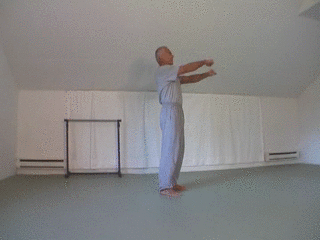 Double arm circles:
Double arm circles: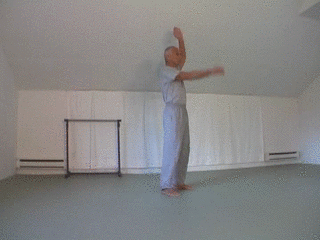
- side-to-side arm swings
- double arm circles
- ankle circles
- shoulder rolls
- lunges with arms overhead
- sitting glute stretch
This illustrates the central idea of the routine: one should develop a core set of movements to do every day, and use those to identify which supplementary movements are needed to fix a particular need of the day. One must constantly be on the hunt for gradual immobility all across one’s body.
The Other Approaches
There are many paths to the same place. I arrived at this particular set of movements through trial and error while suffering the physical slings and arrows of aging, playing judo, and lifting weights Tom Kurz's work, particularly Scientific Stretching and Flexibility Express, was particularly useful during this iterative process.. This is what works for me. But the differences between this approach and another are small. For instance, Steve Kotter, an excellent and respectable physical culturist, demonstrates his mobility routine on fast-forwarded video.
One could also shortcut figuring out the movements I use and just do whatever warm-up you do for regular workouts, whether they be weightlifting, running, or CrossFit. That’s plenty helpful. For instance:
Furthermore, remember to go easy on yourself. Stick to the routine, but don’t beat yourself up if you miss a day because you ran out of time. Everybody misses workouts. I rarely have the time to cover every movement I’d like to do. Each of us has responsibilities that intrude on our personal priorities. But I find it’s helpful to set aside just a few minutes each morning to prioritize my body.
The Movement “Grab Bag”
Here are some exercises I keep handy. This section is very much a work in progress.
Leg Swings
It’s confusingly hard to find a good video/gif example online of the leg swings I recommend. This video clip is OK for the moment:
Generally I prefer a more dynamic effort, as demonstrated by Tom Kurz in these gifs:
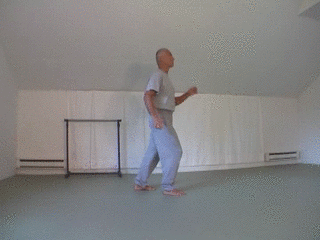
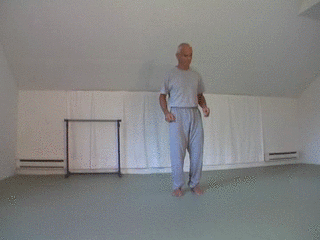
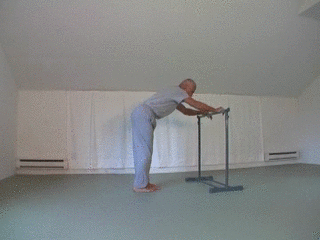
The Squat
All sorts of squats are useful, as both static poses and as transitional movements. For instance, I like to just sit still in a third world squat for several minutes, but I also like to spend thirty seconds leaning onto each ankle, pulling my knees to my chest, and just generally moving around from that position. I also enjoy doing goblet squats, Cossack squats, wide parallel-stanced squats, one-legged “pistol” squats, overhead squats, and so on. These are all fantastic for developing strong knees, as well as mobile hips and ankles. GMB is a beginner’s resource.
”Teacups” exercise from Qi Gong
Here’s a fine example:
If you’re interested in watching lots of people mangle this exercise beyond usefulness, browse YouTube. Martial artists are the worst.
Shoulder stuff
Includes:
- extending arms out to opposite sides, internally rotate one, externally rotate the other
- opposite-direction arm circles
- simultaneous arm circles
- shoulder rolls, alternating or together
Joint rotations
Ankles, wrists, knees, neck–everything benefits from being rolled out 5 to 10 times in each direction.
Hindu/dand/dive-bomber push-ups
As shown in this (lovably ridiculous) Tom Kurz clip:
Specific yoga poses
I found it extremely helpful to go to a yoga class nearly every day for a few months. I still use many poses and movements I learned in that time. It’s important to view yoga classes as education, not just a workout, so that you can harvest the techniques to use later, tailored to your own needs.
— Dave Liepmann, 21 January 2018